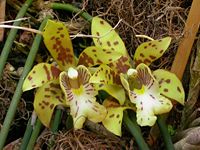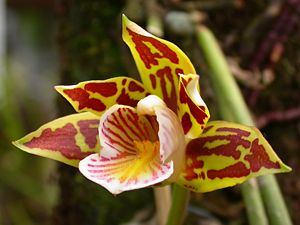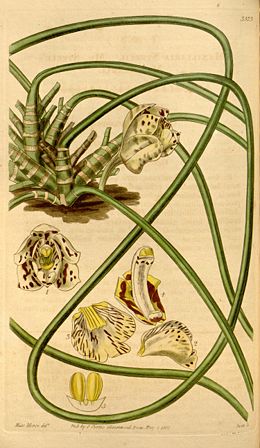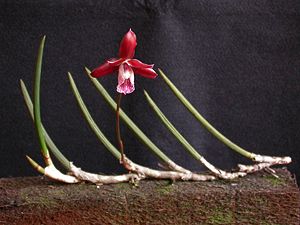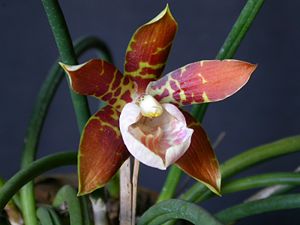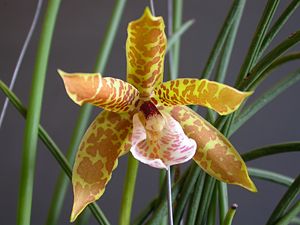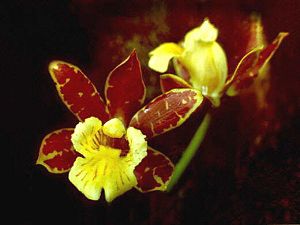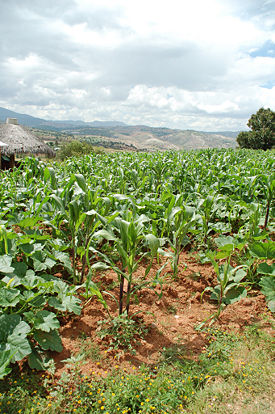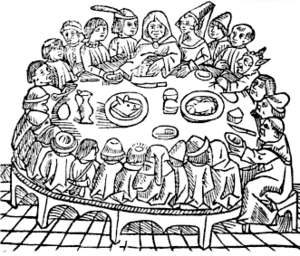Archive:Article of the Week
The Article of the Week is an article chosen by vote among Citizens as exemplifying various qualities we like to see in a Citizendium article; see our article standards.
Add New Nominees Here
To add a new nominee or vote for an existing nominee, click edit for this section and follow the instructions
| Nominated article | Supporters | Specialist supporters | Score |
|---|---|---|---|
| Caesar Schinas 09:25, 8 June 2009 (UTC); Meg Ireland 08:00, 18 June 2009 (UTC) |
Daniel Mietchen 17:24, 4 June 2009 (UTC) | 4 | |
| Milton Beychok 00:15, 29 May 2009 (UTC); Arne Eickenberg 14:15, 17 June 2009 (UTC); Peter Schmitt 23:23, 24 June 2009 (UTC) |
3 | ||
| Milton Beychok 03:04, 7 July 2009 (UTC); |
1
|
Transclusion of the above nominees (to be done by an Administrator)
- Transclude each of the nominees in the above "Table of Nominees" as per the instructions at Template:Featured Article Candidate.
- Then add the transcluded article to the list in the next section below, using the {{Featured Article Candidate}} template.
View Current Transcluded Nominees (after they have been transcluded by an Administrator)
The next article (or draft) of the week will be the article with the most votes at 1 AM UTC on Thursday, 9 July 2009. The honors were done this time by Milton Beychok.
Text in this section is transcluded from the respective Citizendium entries and may change when these are edited.
| Nominated article | Supporters | Specialist supporters | Score | |||||||||||||||||||||||||||||||||||
|---|---|---|---|---|---|---|---|---|---|---|---|---|---|---|---|---|---|---|---|---|---|---|---|---|---|---|---|---|---|---|---|---|---|---|---|---|---|---|
Scuticaria is a genus in the orchid family formed by nine species of showy flowers and long cylindrical leaves. They are epiphytic, occasionally lithophytic or terrestrial, that grow pending and are cespitosus, or reptant and ascending, which exist in three isolated areas of South America, the Amazon Forest in Ecuador and the Serra do Mar and Serra da Mantiqueira mountains in Brazil, both in shady and sunny places. The genus Scuticaria has been traditionally placed close to Maxillaria but recent research shows they are more closely related to the genus Bifrenaria. Despite their interesting appearance, the are hardly seen in nature and, because they culture is complicated, they are not common in private collections and orchid shows either. No other use for these species is reported besides ornamentation. Because it is a well established genus, formed by few species that are reasonably easy to separate, there were few publications about them during the last decades. Distribution and habitDespite there are few species, Scuticaria inhabit varied climates, disperse in a very uneven way though all countries of South America northern to Bolivia, this excluded, and also in areas of Mata Atlântica in Brazilian Southeast. No species is common in nature, being just occasionally or even rarely found. The species with wider range is Scuticaria steelei which inhabits open clearings at higher elevations of central Amazon, jungles known as matas de terra firme, up to eight hundred meters of altitude.[1] Although this species occupies wide area, it is not found very often.[2] Another species from Amazon, however, in a much more restricted area, just in Guyana, in places where the altitude is lower and the humidity is higher, is Scuticaria hadwenii var. dogsonii.[3] Endemic in another area of Amazon, separated but not that far from the habitat of Scuticaria steelei, on southeastern Ecuador, close to the place where the Andes starts, in humid and slightly colder forests, on the mountains up to 1,300 meters of altitude, it is found Scuticaria salesiana.[4] Under the same conditions but in wider areas, that encompass the southeast of Ecuador and northeast of Peru, lives S. peruviana.[5] All species from Amazon are always epiphytic. The remaining species inhabit the area occupied by Brazilian Atlantic Forest. The only species that can be found widespread through several states is Scuticaria hadwenii, in the humid jungles of Serra do Mar from Santa Catarina to Bahia States,[6] generally found living epiphytic at middle height over thick tree stems.[7] Other species occasionally found, although often under living litophytic over rocks and gatherings of fallen leaves in sunny areas of the mountains of São Paulo and Rio de Janeiro, is S. strictifolia.[8] Scuticaria irwiniana, second and last rupicolous species, exists only on the mountains of Minas Gerais State, found in sunny or shadier places up to two thousand meters of altitude.[9] Two are the species from Espírito Santo State, S. novaesii and S. kautskyi, both endemic of restricted areas in the dry jungles of the countryside.[10] The last Scuticaria species is S. itirapinensis, which has been found only a couple of times in the west-central dry woods of São Paulo State, in an area which has been highly deforested, close to Itirapina. There are no records or reports on this species, both in nature and under culture, during the last twenty five years. It is speculated about the possibility of its extinction.[11] DescriptionThe species subordinated to genus Scuticaria are characterized by being plants of thick cylindrical roots covered by thick vellamen. Their stem is formed by a ordinarily short rhizome, slightly elongated in some species; and by cylindrical almost inconspicuous pseudobulbs of the same diameter or slightly thicker than the unique leaf born on their apexes, because they generally are covered by small dried scaling steaths. The leaves may be erect or pending up to one meter long. The inflorescences grow from the said steaths and almost always bear just one flower, exceptionally two in one species, and always is much longer than the pseudobulbs, bearing showy yellow, orange, purple or greenish flowers, with petals and sepals plain, stained or striped, usually by light brown but also by diverse combinations and shades of the other mentioned colors. Ordinarily the labellum presents contrasting colors, frequently with white areas.[8] The flowers are large, wide open, and last during about two weeks.[2] They have sepals of similar sizes and form an almost invisible chin with the column foot. The petals may be similar to the sepals but smaller, or much smaller and with a much narrower base, occasionally showing different patterns or colors. The labellum articulates with the column, is trilobed, with comparatively small lateral lobes and larger terminal, which has variable shapes with diverse patterns and a callus under to column. The later is é semi-cylindrical, slightly arching, erect and thick, without any kind of appendix, ending in an apical anther and elongated in a small foot at the base. The flowers bear to pairs of pollinia of different sizes. The caudicle is narrow and the retinacle is small. The fruits resemble the ones of Maxillaria.[8] There are no observation records of pollinators activities but Scuticaria are supposedly pollinated by Euglossini bees.[7] Taxonomic notesIn May of 1837, the English Botanist William Jackson Hooker received a drawing and a dried sample of a plant, sent by an orchid grower from Liverpool, together with a note explaining that the plant arrived from Demerara, in Guyana, in July of the preceding year. Hooker described this species, classifying it under the genus Maxillaria, calling it M. steelei, in homage to its discover. In his description, Hooker affirms that the plant is highly interesting and an excellent addition to the known epiphytic species because it shows cylindrical leaves almost one meter long, different from anything ever found.[12] few months later, John Lindley published again the species Hooker described, however, adding more information. Two years earlier, several plants had been sent from Demerara and Lindey reports that he had previously informally classified this species as Maxillaria flabellifera which, under this name, could be found in several orchid collection in England. Because he had not yet described this species, he accepts the priority of the name chosen by Hooker. Lindley adds, however, that he had some doubts about the classification, of a species so different from any other known so far, under the genus Maxillaria.[13] In 1843, Lindley published a revision of a group of orchids classified as tribus Maxillaridae, then subordinated to Vandeae, a subfamily of Orchidaceae at the time. In this revision, he indicates that much work is needed till the limits between each genus within this tribus can be established and states his doubts regarding some of the new genera he was proposing, despite being very sure of other ones. Lindley suggested the division of Maxillaridae in twenty five genera, being Scuticaria one of the genera he considered well established. When describing this new genus, Lindley based on morphologic characteristics of Maxillaria steelei Hook., selected as the Type species of Scuticaria with the name Scuticaria steelei.[14] This name comes from Latin scutica, flagellum, in reference to the long cylindrical leaves that the species of this genus show, similar to the leather whips used to punish.[8] Strangely, because he published the genus Scuticaria many years earlier, in 1851, Lindley described another species now considered part of this genus, classifying it under Bifrenaria. It is speculated that possibly because it was found in Brazil on the same area in the southeast where most of Bifrenaria were common, or because he believed that two species separated by so long distance belonged to the same genus. It was Scuticaria hadwenii.[15] Few months later, Jules Émile Planchon corrected Lindley moving it to the genus where it is subordinated today.[16] In 1851, the only two common Scuticaria species were described and the genus well established, therefore no later confusion about the classification of any species subordinated to this genus ever happened.[17] Almost one century passed before any important new information were published. In 1881 Heinrich Gustav Reichenbach described Scuticaria dogsonii, originated from Guyana,[3] but in 1892, Berthold Stein, considering that the only difference it shows from Scuticaria hadwenii is the fact it bears two flowers each inflorescence, reduced it to a variety of the later.[18] In 1903, Célestin Alfred Cogniaux, when revising all orchids species from Brazil, cites two other varieties of Scuticaria hadwenii which, because just show color differences, can not be accepted as such today.[19] Finally, in 1947, Frederico Carlos Hoehne described a new species, Scuticaria strictifolia, yet similar to Scuticaria hadwenii, although showing some slight differences on the labellum structure, besides their normally lithophytic habit and erect leaves.[20] If few species were known so far, after 1968 the number of described species triplicated. All species described during the later years are uncommon and inhabit restricted areas, some are very rare or even supposedly exctinct. In 1968 Robert Louis Dressler described Scuticaria salesiana, discovered in Ecuador in an area far apart from the other Scuticaria range.[4] In 1972, Guido Pabst described Scuticaria kautskyi, found in Espírito Santo State, [21] in southeast Brazil and, during the following year, published two species at once, S. itirapinensis and S. irwiniana.[22] In 1982, other species was discovered in Espírito Santo, Scuticaria novaesii.[10] The last described species was S. peruviana, found in Peru in 2002, in the same region of S. salesiana, to which it is related.[5] Despite Lindley indicated the possibility of Scuticaria being closely related to Bifrenaria when he initially described S. hadwenii under this genus, all later taxonomists always included Scuticaria on the same group Maxillaria were.[23] It was just in 2000 that the first proofs of Scuticaria closer proximity to Bifrenaria started being published.[24] In 2002, a detailed research about the phylogeny of Bifrenaria performed molecular analyses on two Scuticaria species while chosing them as out groups. This study claims that the phylogenethic internal relationships among Scuticaria species so far remain unknown.[25] It is known that other orchid genera bearing cylindrical leaves devolved this sort of leaves as a defense to climate changes their habitats were going through along the eras. Terete leaves are capable of much more water and nutrients and to face longer drought periods than species bearing thin leaves, on the other hand, almost all epiphytic species presenting the former type of leaves show more or less atrophied pseudobulbs since the leaves carry on its accumulating role. It is a supposition that Scuticaria species should have once inhabited much drier through their evolution. Because most of the species are found in shadier and more humid species now, this may one of the reasons why their culture uses to be complicated, possibly because the delicate balance they reached in nature is broken. For the same reason it is supposed their frequency in nature is only occasion or rare.[7] SpeciesBecause of its highly particular morphologic characteristics which allow immediate identification, their restricted species distribution, and their comparatively low variability, since the genus Scuticaria was established by Lindley, only then species were formally described and it has never been great confusion separating each species. Form these ten, nine are generally accepted, the tenth being ordinarily considered a variety, and, under this condition, also accepted.[17] For identification purposes, the species can be split as follow: Only two species present erect leaves and are the only ones frequently found as lithophytes, Scuticaria irwiniana, easily known recognized because of its flowers without any stains on the internally entirely purple and externally whitish sepals and petals, with white labellum, striped of purple. This species generally can be identified even without flowers because of its reptant, slightly ascendant growth, and longer rhyzome than any other species.[22] Scuticaria strictifolia also has erect leaves but occasionally, when cultivated under insufficient light, their leaves can be narrower and slightly bent making the distracted observer find hard to differentiate it from S. hadwenii.[8] The Brazilian taxonomist Guido Pabst considered this species a variety of the later.[9] All species remaining are ephiphytic with pendent habit. Scuticaria hadwenii, due to its several more or less isolated groups of populations along Serra do Mar, mostly on the west side of this chain of mountains, spreading throughout the interior highland in some states of Brazil, is the Scuticaria species that presents most variable colors.[8] It can be separated from S. strictifolia because shows leaves always pending, flowers of more vivid colors and by the interior of the labellum, which ordinarily is more pubescent. There is a variety denominated dogsonii, native from Guyana, which is more floriferous.[3] The two other species from Espírito Santo State are highly different to each other. Scuticaria kautskyi usually has more or less uniform orange color on its sepals and petals, with their bases slightly lighter and dotted of greenish yellow. Their labellum is white showing few colored drawings and narrow terminal lobe, slightly deflected.[21] The other species from this state, Scuticaria novaesii presents flowers with green-yellow segments, intensely spotted with dark brown and wide and flat labellum terminal lobe, with clearly marked by radial multicolored lines.[10] Scuticaria itirapinensis, the last species of brazilian southeast, is the one that closely resembles Amazonian Scuticaria steelei, although it can be easily separeted because of its strong yellow flowers and much shorter leaves, besides slight differences on the proportions of floral structures.[22] A Scuticaria steelei presents entirely pale yellow flowers, completely covered by spaced small darker stains, However in is not even necessary to observe the flowers to identify it as their leaves are about one meter long, and there are references of plants measuring almost one and a half meter.[2] The last two Scuticariaare isolated in forests of Peru and Ecuador and are similar to each other. They are different from all other because of the proportions of floral segments. The labellum is much larger when compared to their sepals and petals than it is on other species. Moreover, their petals are striped of brown and much smaller than the sepals, showing a greater difference than it is found on the other species. From each other, they can be separated mostly by the shape of the labellum. Scuticaria salesiana presents more rounded intermediate lobe, and Scuticaria peruviana has it more rectangular, with the apex truncated, almost in a straight line.[5] In 2008, a new species of Scuticaria, S. bahiensis has been described from Bahia state in Brazil but so far it remains mostly unknown.[26] CultureIn his book Flora Brasilica, the Brazilian Botanist Frederico Hoehne strongly recommended the culture of Scuticaria species because of their beautiful flowers and interesting vegetation, however, soon later he admits that all species then cultivated by São Paulo Botanic Garden had died after two or three years. Indeed, he claims that to successfully grow them a special environment needs to be created.[8] These plants are not easy to maintain under culture. Only recently, with the help of modern technology, timers and foggers that keep the humidity constant, the growers have been finally capable of keeping them out of their natural environment for several years. There are four different sorts of culture according to the origin of each species. S. steelei and S. hadwenii var. dogsonii are the species that need higher temperature and humidity. The two rupicolous species, S. irwiniana and S. strictifolia ate the ones which need more light and constant ventilation besides drier culture conditions.[22] S. peruviana and S. salesiana take slightly cooler temperatures than the other species although still need humidity mostly during the early morning hours.[5] The other species need less light than the mentioned ones. All species should be preferably mounted on plaques of vegetable fibers because of their pending habit, the rupicolous species may alternatively potted in well drained pots. Scuticaria are delicate plants that like to remain untouched during several years because their roots easily resent on replants.[7] References
|
Caesar Schinas 09:25, 8 June 2009 (UTC); Meg Ireland 08:00, 18 June 2009 (UTC); |
Daniel Mietchen 17:24, 4 June 2009 (UTC) | 4
| |||||||||||||||||||||||||||||||||||
Milpa agriculture is a form of swidden agriculture that is practiced in Mesoamerica. Traditionally, a "milpa" plot (from the Nahuatl word for "corn field") is planted with maize, beans, and squash (known as the Three Sisters) and might include a variety of other plants. These plots are planted for two or three years and then allowed to lie fallow for some years in order to restore the fertility of the soil. Milpa agriculture varies somewhat by region and it has changed in a variety of ways in different areas but it remains an important part of life for millions of people throughout Mesoamerica. Maize and beansMaize and beans, which are the staples of the Mesoamerican diet, complement each other in terms of the health of the fields as well as the health of the people who eat them. Maize requires high levels of nitrogen in the soil to grow properly and quickly depletes the soil if planted alone. Bean plants (genus Phaseolus), on the other hand, are high in nitrogen and their presence extends the life of the maize plot significantly by helping to keep nitrogen levels healthy. One might say that the maize repays the debt it owes to the beans by providing stalks for the bean plants to cling to as they grow. Squashes, generally grown between the rows of maize stalks, also figure into this symbiotic relationship, as they cover the ground in between the rows of corn and help to keep weeds down. Maize and beans also compliment each other nutritionally. If eaten alone, one would need to consume large amounts to fulfill human dietary requirements but when eaten together, they achieve "protein complimentarity."[1] That is to say, a person needs less total food if the two are eaten together. This diet is further supplemented by several varieties of squash and other foods that are planted along side the maize and beans. In many areas, the "Mesoamerican trio" (maize, beans and squash) is complemented by wild or semi-domesticated plants that grow in and around the milpa. Planting and harvestingMilpas are traditionally cultivated using the swidden, or "slash and burn" system. The forest is cut, allowed to dry and then burned. The left over ashes are then mixed into the soil as a fertilizer. Maize and beans are planted together in the same hole while squash is planted separately, in between the rows of maize. Other cultigens may be planted in a separate section of the field or scattered among the maize. The fields must be weeded several times throughout out the season. This is backbreaking work, especially in areas where a milpa is likely to be planted on the slope of a mountain several hours walk from home and it is usually done mostly by hand with the help of machetes and hoes. Later in the season, weeding is less needed, as the broad leaves of the squash plants keep unwanted plants to a minimum and the maize grows out of reach of the weeds. Beans and squash are harvested as they ripen. As the maize ripens, a few elotes (or fresh cobs) may be picked to be eaten right away but most of the plants are bent near the top and the cobs are allowed to dry in the field. Once they are dry, they are collected and stored for later use in traditional Mesoamerican foods like tortillas and tamales. The dry stalks are often collected and sold at market as fodder for animals and the husks are frequently saved for use in preparing tamales. The weeds and left over corn stalks from the previous season will be burned to prepare the fields for planting for one or two more years but then they will be left to fallow for as much as ten or more years. This practice has been abandoned in many areas because of the shortage of land that is available to many families. Instead, animal dung or ashes from the hearth at home may be added to those mixed into the soil and many farmers have turned to industrial fertilizers that allow them to cultivate the same plot year after year. The ritual life of the milpaSeveral important rituals are performed at key points during the growing season. The timing of these rituals varies by region and altitude due to variations in climate and the length of the growing season but they are invariably tied to significant events in the ritual calendar. Among the Maya, agricultural rituals are performed at the full moon[2] while in central Mexico, each ceremony is associated with one of the eighteen months in the solar calendar and occur at periods of twenty days.[3] Ceremonies are performed at each major stage in the development of the maize, beginning with the planting and concluding with the harvest. Agricultural rituals also vary in form according to local traditions, but common themes are found throughout Mesoamerica. One such theme is the ritual reenactment of the creation of the world by marking the four cardinal directions. Among the K'iche' of highland Guatemala, offerings are made at the four corners of the milpa. The Kekchi plant maize in the center of the field first and then plant in each of the fours directions.[2] In Tepotzlán, the Nahuas place crosses made from pericón at the four corners of the field.[3] And in the Sierra Madre of northern Mexico, the Tarahumara open their work parties by scattering tesguino, or corn beer, to the four directions.[4][5] Other themes include sacrifices and offerings to indigenous deities or Catholic saints and prayers for rain. Maize also figures prominently in ritual activities that are not directly connected to the cultivation of the milpa. In Amatlán, Nahua villagers say, "Corn is our blood,"[6] meaning, "corn defines our way of life" in everything from ethnic identity to every day activities. In fact, the Popul Vuh reveals that the first mothers and fathers of the Maya were actually formed from maize.[7] Maize, and especially the intimate connection between maize and humans, arises again and again in both ancient and modern myths. Modern trendsOne consequence of the changes in land ownership patterns introduced through Spanish colonial society and some of the agrarian reforms carried out by the modern states in the region is that many families do not own enough land to produce all of the food that they need in a year. Consequently, the practice of fallowing the fields has disappeared or nearly disappeared in many areas. Today, many farmers use chemical fertilizers to increase their fields’ production and engage in other economic activities to earn enough money to provide for their families. Even when farmers have access to enough land to feed their own families, they are often unable to market their surplus. Trade liberalization and market deregulation policies adopted throughout the region in the 1980s and 1990s have meant that maize and other staple crops produced on a very large scale by U.S. corporations are frequently available at lower prices in local markets than the products of local farmers.[8] Thus, many farmers have also converted their fields to other crops. Today, cash crops destined for export to the U.S. include broccoli, snow peas, cucumbers, Brussels sprouts, and carnations. Despite the market pressures felt by small scale farmers in Mesoamerica to turn away from traditional agriculture, milpas may hold information that can help improve modern agricultural methods. Monocrop agriculture creates artificial growing conditions that are significantly less biologically diverse than the natural ecosystems that they replace. This results in rapid depletion of the soil, which is generally counteracted by the application of chemical fertilizers that return nutrients to the soil but may have damaging effects in the long-term. Though it is unlikely that the balancing diversity of milpa agriculture can be reproduced on an industrial scale, the indigenous knowledge embedded in its design may provide some guidelines for improving industrial techniques. "By studying [the milpa's] essential features," writes Charles C. Mann, "researchers may be able to smooth the rough ecological edges of conventional agriculture."[9] Notes
|
Milton Beychok 00:15, 29 May 2009 (UTC); Arne Eickenberg 14:15, 17 June 2009 (UTC); Peter Schmitt 23:23, 24 June 2009 (UTC); |
3
| ||||||||||||||||||||||||||||||||||||
The Canterbury Tales is a collection of tales written by Geoffrey Chaucer between 1387 and 1400[1], two of them in prose, the rest in verse. The tales, some of which are originals and others not, are contained inside a frame tale and told by a group of pilgrims on their way from Southwark to Canterbury to visit the shrine of Saint Thomas Becket at Canterbury Cathedral.[2] The Canterbury Tales are remarkable for having been written in the vernacular, Middle English, rather than the language of courtiers (French) or of the church (Latin). From the earliest days of their appearance to the present moment, they have been recognized as a foundational pillar of English literature. The Oxford English Dictionary says that "in later times" the phrase "Canterbury Tale" is "often taken as" being "a long tedious story, a fable, a cock-and-bull story".[3] Poetic structureMuch of The Canterbury Tales is in iambic pentameters with an AABB rhyming scheme, but a few tales were written in other forms, among them the ballad stanza. The individual talesThe themes of the tales vary, and include topics such as courtly love, treachery, and avarice. The genres also vary, and include romance, Breton lai, sermon, beast fable, and fabliau. The characters, introduced in the General Prologue of the book, tell tales of great cultural relevance. The Tales include: Some of the tales are serious and others humorous; however, all are very precise in describing the traits and faults of human nature. Antifraternal and anti-clerical themes abound, along with instances of courtly romance, fabliaux, and the traditional ballad. The work is incomplete, at least if we take at face value the claim in the General Prologue that each character would tell four tales, two on the way to Canterbury and two on the return journey. This would have meant a possible one hundred and twenty tales which would have dwarfed the twenty-six tales actually written. The missing tales inspired many, some quite soon after Chaucer's death in 1400, to write their own additional tales, among them the spurious Plowman's Tale and the Tale of Beryn, a continuation of the narrative which includes the pilgrims' eventual arrival in Canterbury itself as well as the beginning of the return journey. From the 14th century to the present, readers have found political overtones within the tales, particularly as Chaucer himself was a significant courtier and political figure at the time, close to the corridors of power. Chaucer's wife Philippa (de) Roet was the sister of John of Gaunt's favourite mistress (afterwards third wife), Katherine Swynford, and Chaucer had close ties with the so-called Lollard Knights. There are many hints at contemporary events, although few are proven, and the theme of marriage common in the tales is presumed to allude to several different marriages, most often those of John of Gaunt. In addition to Chaucer himself, Harry Bailly of the Tabard Inn was a real person and the Cook has been identified as quite likely to be Roger Knight de Ware, a contemporary London, United Kingdom cook. The complete workThe work was probably begun in the 1380s with Chaucer stopping work at some point in the late 1390s prior to his death in 1400. It was not written down fully conceived: it seems to have had many revisions with the addition of new tales at various times. The plan for one hundred and twenty tales is from the general prologue. It is announced by Harry Bailly, the host, that there will be four tales each. This is not necessarily the opinion of Chaucer himself, who appears as the only character to tell more than one tale. It has been suggested that the unfinished state was deliberate on Chaucer's part. The structure of The Canterbury Tales is a frame narrative and easy to find in other contemporary works, such as The Book of Good Love by Juan Ruiz and Boccaccio's Decameron, which may have been one of Chaucer's main sources of inspiration. Chaucer indeed adapted several of Boccaccio's stories to put in the mouths of his own pilgrims, but what sets Chaucer's work apart from his contemporaries' is his characters. Compared to Boccaccio's main characters - seven women and three men, all young, fresh and well-to-do, and given Classical names - the characters in Chaucer are of extremely varied stock, including representatives of most of the branches of the middle classes at that time. Not only are the participants very different, but they tell very different types of tales, with their personalities showing through both in their choices of tales and in the way they tell them. The idea of a pilgrimage appears to have been mainly a useful device to get such a diverse collection of people together for literary purposes. The Monk would probably not be allowed to undertake the pilgrimage and some of the other characters would be unlikely ever to want to attend. Also all of the pilgrims ride horses, there is no suggestion of them suffering for their religion. None of the popular shrines along the way are visited and there is no suggestion that anyone attends mass, so that it seems much more like a tourist's jaunt. Chaucer does not pay that much attention to the progress of the trip. He hints that the tales take several days but he does not detail any overnight stays. Although the journey could be done in one day this speed would make telling tales difficult and three to four days was the usual duration for such pilgrimages. The 18th of April is mentioned in the tales and Walter William Skeat, a 19th-century editor, determined 17 April 1387 as the probable first day of the tales. Scholars divide the tales into ten fragments. The tales that make up a fragment are directly connected, usually with one character speaking to and handing over to another character, but there is no connection between most of the other fragments. This means that there are several possible permutations for the order of the fragments and consequently the tales themselves. The above listing is perhaps the most common in modern times, with the fragments numbered I-X, but an alternative order lists them A-G, with the tales from the Physician's until the Nun's Priest's placed before the Wife of Bath's. The exception to the independence between fragments are the last two. The Manciple's tale is the last tale in IX but fragment X starts with the Parson's prologue by saying that the Manciple had finished his tale. The reason that they are kept as two different fragments is that the Manciple starts his short tale in the morning but the Parson's tale is told at four in the afternoon. It is assumed that Chaucer would have amended his manuscript or inserted more tales to fill the time. Two early manuscripts of the tale are the Hengwrt Chaucer manuscript and the Ellesmere manuscript. Altogether, the Tales survives in eighty-four manuscripts and four printed editions dating from before 1500. The Canterbury Tales Project is transcribing the whole text of all these versions, comparing them to attempt to uncover how they are related, and publishing transcripts, images and analyses of all this: see further the links in References, below. SignificanceLike Dante, Chaucer's greatest contribution that this work made to English literature was in popularising the literary use of the vernacular language, English (rather than French or Latin). Some of Chaucer's contemporaries, such as John Gower, also wrote some of their literary output in English, and yet only Chaucer staked his all on English, while at the same time taking inspiration from continental writers in the vernacular, such as Dante and Boccaccio. Within the tradition of English verse, Chaucer's output helped to assure the predominance of continental verse forms, in particular rhymed verse, over the traditional alliterative form. The pilgrims' route and real locationsThe pilgrims would probably have travelled along Watling Street, a route ancient even in Chaucer's time. Used by the Celts, paved by the Romans and named by the Anglo-Saxons, the stretch from London to Canterbury and then Dover is now the A2 road. The City of Canterbury has a museum dedicated to The Canterbury Tales".[4] The postulated return journey has intrigued many and continuations have been written as well as tales written for the characters who are mentioned but not given a chance to speak. The Tale of Beryn is a story by an anonymous author within a 15th-century manuscript of the work. The tales are rearranged and there are some interludes in Canterbury, which they had finally reached, and Beryn is the first tale on the return journey, told by the Merchant. John Lydgate's Siege of Thebes is also a depiction of the return journey but the tales themselves are actually prequels to the tale of classical origin told by the Knight in Chaucer's work. MiscellaneaThe title of the work has become an everyday phrase in the language and has been variously adapted and adopted. Recently an animated version of some of the tales has been produced for British television. As well as a version with Modern English dialogue, there were versions in the original Middle English and Welsh. Evolutionist Richard Dawkins used The Canterbury Tales as a structure for his 2004 book about evolution - The Ancestor's Tale: A Pilgrimage to the Dawn of Evolution. His animal pilgrims are on their way to find the common ancestor, each telling a tale about evolution. In the U.S., The Canterbury Tales has been expurgated since its first appearance; it was subjected to revisions as late as 1928. In 1995, the book was challenged at Eureka Illinois High School for its lewd content and banned. Idries Shah in The Sufis wrote of evidence that the work was based on Fariduddin Attar's 12th-century work The Parliament Of The Birds citing various similarities between the two works[5]. Like Attar, Chaucer had thirty participants in his pilgrimage and both works are an allegory of inner development. "The Pardoner's Tale" occurs in Attar's work, whilst the pear-tree story is found in Book IV of the Mathnawi by the 13th century author Rumi[5]. Stage and film adaptations and allusions
Notes
|
Milton Beychok 03:35, 7 July 2009 (UTC); |
1
|
Current Winner (to be selected and implemented by an Administrator)
To change, click edit and follow the instructions, or see documentation at {{Featured Article}}. Torture (Read more...)
Previous Winners
 Miltonia: An orchid genus formed by nine showy epiphyte species and seven natural hybrids of Brazil, one species reaching Argentina and Paraguay. [e] (June 25)
Miltonia: An orchid genus formed by nine showy epiphyte species and seven natural hybrids of Brazil, one species reaching Argentina and Paraguay. [e] (June 25) Ancient Celtic music: The music and instruments of the ancient Celts until late Antiquity. [e] (June 18)
Ancient Celtic music: The music and instruments of the ancient Celts until late Antiquity. [e] (June 18) Bifrenaria: A genus of orchids formed by circa twenty species of South America, some widely cultivated because of their large and colored flowers; divided in two distinct groups, one with large flowers and short inflorescences and the other with small flowers and long inflorescences. [e] (June 11)
Bifrenaria: A genus of orchids formed by circa twenty species of South America, some widely cultivated because of their large and colored flowers; divided in two distinct groups, one with large flowers and short inflorescences and the other with small flowers and long inflorescences. [e] (June 11) Halobacterium NRC-1: A microorganism from the Archaea kingdom perfectly suited for life in highly saline environments giving biologists an ideal specimen for genetic studies. [e] (June 4)
Halobacterium NRC-1: A microorganism from the Archaea kingdom perfectly suited for life in highly saline environments giving biologists an ideal specimen for genetic studies. [e] (June 4) Animal: A multicellular organism that feeds on other organisms, and is distinguished from plants, fungi, and unicellular organisms. [e] (May 28)
Animal: A multicellular organism that feeds on other organisms, and is distinguished from plants, fungi, and unicellular organisms. [e] (May 28) Coal: a combustible, black rock formed after millions of years of heat and pressure were applied to the decayed remains of plants and organic matter in what were then swamps. [e] (May 21)
Coal: a combustible, black rock formed after millions of years of heat and pressure were applied to the decayed remains of plants and organic matter in what were then swamps. [e] (May 21) Johannes Diderik van der Waals: (1837 – 1923) Dutch scientist, proposed the van der Waals equation of state for gases. [e] (May 7)
Johannes Diderik van der Waals: (1837 – 1923) Dutch scientist, proposed the van der Waals equation of state for gases. [e] (May 7) Scientific method: The concept of systematic inquiry based on hypotheses and their testing in light of empirical evidence. [e] (Apr 14)
Scientific method: The concept of systematic inquiry based on hypotheses and their testing in light of empirical evidence. [e] (Apr 14) Korematsu v. United States: A U.S. Supreme Court case, in which the internment of Japanese-Americans was deemed constitutional due to military necessity [e] (Apr 7)
Korematsu v. United States: A U.S. Supreme Court case, in which the internment of Japanese-Americans was deemed constitutional due to military necessity [e] (Apr 7) Orchid: Any plant classified under Orchidaceae, one of the largest plant families and the largest among Monocotyledons. [e] (Mar 31)
Orchid: Any plant classified under Orchidaceae, one of the largest plant families and the largest among Monocotyledons. [e] (Mar 31) Oliver Cromwell: (1599-1658) English soldier, statesman, and leader of the Puritan revolution, nicknamed "Old Ironsides". [e] (Mar 24)
Oliver Cromwell: (1599-1658) English soldier, statesman, and leader of the Puritan revolution, nicknamed "Old Ironsides". [e] (Mar 24) Wisconsin v. Yoder: 1972 U.S. Supreme Court decision in which it was held that the constitutional rights of the Amish, under the "free exercise of religion" clause, were violated by the state's compulsory school attendance law. [e] (Mar 17)
Wisconsin v. Yoder: 1972 U.S. Supreme Court decision in which it was held that the constitutional rights of the Amish, under the "free exercise of religion" clause, were violated by the state's compulsory school attendance law. [e] (Mar 17) Conventional coal-fired power plant: power plant that burns coal in a steam generator to produce high pressure steam, which goes to steam turbines that generate electricity. [e] (Mar 10)
Conventional coal-fired power plant: power plant that burns coal in a steam generator to produce high pressure steam, which goes to steam turbines that generate electricity. [e] (Mar 10) Battle of the Ia Drang: First divisional-scale battle involving helicopter-borne air assault troops, with U.S. forces against those of North Vietnam [e] (Mar 3)
Battle of the Ia Drang: First divisional-scale battle involving helicopter-borne air assault troops, with U.S. forces against those of North Vietnam [e] (Mar 3) Ether (physics): Medium that can carry electromagnetic waves (obsolete) [e] (Feb 24)
Ether (physics): Medium that can carry electromagnetic waves (obsolete) [e] (Feb 24) Large-scale trickle filters: One of the processes by which biodegradable substances in wastewaters are biochemically oxidized. [e] (11 Feb)
Large-scale trickle filters: One of the processes by which biodegradable substances in wastewaters are biochemically oxidized. [e] (11 Feb) Homeopathy: System of alternative medicine involving administration of highly diluted substances with the intention to stimulate the body's natural healing processes, not considered proven by mainstream science. [e] (28 Jan)
Homeopathy: System of alternative medicine involving administration of highly diluted substances with the intention to stimulate the body's natural healing processes, not considered proven by mainstream science. [e] (28 Jan) Microeconomics: A branch of economics that deals with transactions between suppliers and consumers, acting individually or in groups. [e] (14 Jan)
Microeconomics: A branch of economics that deals with transactions between suppliers and consumers, acting individually or in groups. [e] (14 Jan) Speech Recognition: The ability to recognize and understand human speech, especially when done by computers. [e] (26 Nov)
Speech Recognition: The ability to recognize and understand human speech, especially when done by computers. [e] (26 Nov) Mashup: A data visualization created by combining data with multiple computer applications. [e] (19 Nov)
Mashup: A data visualization created by combining data with multiple computer applications. [e] (19 Nov) Tux: The name of the penguin, official logo and cartoon mascot for the Linux computer operating system. [e] (14 Oct)
Tux: The name of the penguin, official logo and cartoon mascot for the Linux computer operating system. [e] (14 Oct) Hydrogen bond: A non-covalent and non-ionic chemical bond involving a hydrogen atom and either Fluorine, Nitrogen, or Oxygen. [e] (7 Oct)
Hydrogen bond: A non-covalent and non-ionic chemical bond involving a hydrogen atom and either Fluorine, Nitrogen, or Oxygen. [e] (7 Oct) Lead: Chemical element number 82, a corrosion-resistant, dense, ductile heavy metal known to cause neurological problems. [e] (1 Sept)
Lead: Chemical element number 82, a corrosion-resistant, dense, ductile heavy metal known to cause neurological problems. [e] (1 Sept) DNA: A macromolecule — chemically, a nucleic acid — that stores genetic information. [e] (8 July)
DNA: A macromolecule — chemically, a nucleic acid — that stores genetic information. [e] (8 July) Augustin-Louis_Cauchy: (1789 – 1857) prominent French mathematician, one of the pioneers of rigor in mathematics and complex analysis. [e] (1 July)
Augustin-Louis_Cauchy: (1789 – 1857) prominent French mathematician, one of the pioneers of rigor in mathematics and complex analysis. [e] (1 July) Vasco da Gama: Portuguese explorer who established a sea route from Europe to India. [e] (24 June)
Vasco da Gama: Portuguese explorer who established a sea route from Europe to India. [e] (24 June) Phosphorus: Chemical element (Z=15) vital to life and widely used in fertilizers, detergents and pesticides. [e] (17 June)
Phosphorus: Chemical element (Z=15) vital to life and widely used in fertilizers, detergents and pesticides. [e] (17 June) Crystal Palace: A glass and iron structure built to house the Great Exhibition in Hyde Park, London, in 1851. It was moved and rebuilt on Sydenham Hill in 1854 but was destroyed by fire in 1936. [e] (10 June)
Crystal Palace: A glass and iron structure built to house the Great Exhibition in Hyde Park, London, in 1851. It was moved and rebuilt on Sydenham Hill in 1854 but was destroyed by fire in 1936. [e] (10 June) Gross Domestic Product: Gross Domestic Product (GDP) is a total of the outputs recorded in a country’s national income accounts. [e] (3 June)
Gross Domestic Product: Gross Domestic Product (GDP) is a total of the outputs recorded in a country’s national income accounts. [e] (3 June) RNA interference: Process that inhibits the flow of genetic information to protein synthesis. [e] (27 May)
RNA interference: Process that inhibits the flow of genetic information to protein synthesis. [e] (27 May) Latino history: History of Hispanics in the U.S., especially those of Mexican origins. [e] (20 May)
Latino history: History of Hispanics in the U.S., especially those of Mexican origins. [e] (20 May) Navy Grog: Rum-based drink. [e] (13 May)
Navy Grog: Rum-based drink. [e] (13 May) Systems biology: The study of biological systems as a whole. [e] (6 May)
Systems biology: The study of biological systems as a whole. [e] (6 May) Steroid: Hormone group that controls metabolism, catabolism, growth, electrolyte balance and sexual characteristics. [e] (22 Apr)
Steroid: Hormone group that controls metabolism, catabolism, growth, electrolyte balance and sexual characteristics. [e] (22 Apr) Lebanon: a country in the Middle East. It borders Syria to the north and east, Israel to the south, and the Mediterranean Sea to the west. Its official language is Arabic, although French is widely spoken. The capital and largest city of Lebanon is Beirut. [e] (15 Apr)
Lebanon: a country in the Middle East. It borders Syria to the north and east, Israel to the south, and the Mediterranean Sea to the west. Its official language is Arabic, although French is widely spoken. The capital and largest city of Lebanon is Beirut. [e] (15 Apr) Wheat: Grass crop grown worldwide and used in making flour and fermentation for alcohol production. [e] (7 Apr)
Wheat: Grass crop grown worldwide and used in making flour and fermentation for alcohol production. [e] (7 Apr) Benjamin Franklin: 1706-1790, American statesman and scientist, based in Philadelphia. [e] (1 Apr)
Benjamin Franklin: 1706-1790, American statesman and scientist, based in Philadelphia. [e] (1 Apr) Coherer: A type of radio detector, popular in the earliest days of radio development, beginning around 1890. [e] (25 Mar)
Coherer: A type of radio detector, popular in the earliest days of radio development, beginning around 1890. [e] (25 Mar) U.S. Civil War: {1861-65) war by the U.S. to prevent 11 of its states (the Confederate States of America) from seceding; won by the U.S. after the death of 600,000 people and the abolishment of slavery. [e] (18 Mar)
U.S. Civil War: {1861-65) war by the U.S. to prevent 11 of its states (the Confederate States of America) from seceding; won by the U.S. after the death of 600,000 people and the abolishment of slavery. [e] (18 Mar) Life: Add brief definition or description (11 Mar)
Life: Add brief definition or description (11 Mar) Petroleum refining processes: Add brief definition or description (4 Mar)
Petroleum refining processes: Add brief definition or description (4 Mar) Shirley Chisholm: Add brief definition or description (20 Feb)
Shirley Chisholm: Add brief definition or description (20 Feb) Telephone Newspaper: Add brief definition or description (4 Feb)
Telephone Newspaper: Add brief definition or description (4 Feb) Wristwatch: Add brief definition or description (28 Jan)
Wristwatch: Add brief definition or description (28 Jan) Korean War of 1592-1598: Add brief definition or description (21 Jan)
Korean War of 1592-1598: Add brief definition or description (21 Jan) Andrew Carnegie: Add brief definition or description (11 January 2008)
Andrew Carnegie: Add brief definition or description (11 January 2008)- Bowling: Add brief definition or description (31 December 2007)
 Architecture: Add brief definition or description (December 6)
Architecture: Add brief definition or description (December 6) Civil society: Add brief definition or description November 29
Civil society: Add brief definition or description November 29 Joan of Arc: Add brief definition or description (November 22)
Joan of Arc: Add brief definition or description (November 22) Chemistry: Add brief definition or description (November 15)
Chemistry: Add brief definition or description (November 15) Albert Gallatin: Add brief definition or description (November 8)
Albert Gallatin: Add brief definition or description (November 8) Prime number: Add brief definition or description (November 1)
Prime number: Add brief definition or description (November 1) Tennis: Add brief definition or description (October 25)
Tennis: Add brief definition or description (October 25) Rottweiler: Add brief definition or description (October 18)
Rottweiler: Add brief definition or description (October 18) Theodor Lohmann: Add brief definition or description (October 9)
Theodor Lohmann: Add brief definition or description (October 9) William Shakespeare: Add brief definition or description (October 2)
William Shakespeare: Add brief definition or description (October 2) Edward I: Add brief definition or description (September 25)
Edward I: Add brief definition or description (September 25) El Tío: Add brief definition or description (September 18)
El Tío: Add brief definition or description (September 18) Scotland Yard: Add brief definition or description (September 11)
Scotland Yard: Add brief definition or description (September 11) Kilt: Add brief definition or description (September 4)
Kilt: Add brief definition or description (September 4) U.S. Electoral College: Add brief definition or description (August 28)
U.S. Electoral College: Add brief definition or description (August 28) Butler: Add brief definition or description (August 21)
Butler: Add brief definition or description (August 21) Tony Blair: Add brief definition or description (August 14)
Tony Blair: Add brief definition or description (August 14) Northwest Passage: Add brief definition or description (August 7)
Northwest Passage: Add brief definition or description (August 7) Literature: Add brief definition or description (July 31)
Literature: Add brief definition or description (July 31) Biology: Add brief definition or description (July 25)
Biology: Add brief definition or description (July 25)
Rules and Procedure
Rules
- The article's status must be 0 or 1, i.e., only "Advanced Articles" may be nominated.
- Any Citizen may nominate an article.
- No Citizen may have nominated more than one article listed under "current nominees" at a time.
- The article's nominator is indicated simply by the first name in the list of votes (see below).
- At least for now--while the project is still small--you may nominate and vote for articles of which you are a main author.
- An article can be Article of the Week only once every six months. Nominated articles that have won top honors should be removed from the list.
- Comments on nominations should be made on the article's talk page.
- The list of nominees should be kept below 20, or thereabouts. Articles with very few supporters and which have not gained any new supporters in the last two weeks or so may be deleted to make room for new nominees.
- Any editor may entirely cancel the nomination of any unapproved article in his or her area of expertise if, for example, it contains obvious and embarrassing problems.
Voting
- To vote, add your name and date in the Supporters column next to an article title, after other supporters for that article, by signing
<br />~~~~. (The date is necessary so that we can determine when the last vote was added.) Your vote is alloted a score of 1. - Add your name in the Specialist supporters column only if you are an editor who is an expert about the topic in question. Your vote is alloted a score of 1 for articles which you created and a score of 2 for articles which you did not create.
- You may vote for as many articles as you wish, and each vote counts separately, but you can only nominate one at a time; see above. You could, theoretically, vote for every nominated article on the page, but this would be pointless.
Ranking
- The list of articles is sorted by number of votes first, then alphabetically.
- Admins should make sure that the votes are correctly tallied, but anyone may do this. Note that "Specialist Votes" are worth 3 points.
Updating
- Each Thursday, one of the admins listed below should move the winning article to the Current Winner section of this page, announces the winner on Citizendium-L and updates the "previous winning articles" section accordingly.
- The winning article will be the article at the top of the list (ie the one with the most votes).
- In the event of two or more having the same number of votes :
- The article with the most specialist supporters is used. Should this fail to produce a winner, the article appearing first by English alphabetical order is used.
- The remaining winning articles are guaranteed this position in the following weeks, again in alphabetical order. No further voting would take place on these, which remain at the top of the table with notices to that effect. Further nominations and voting take place to determine future winning articles for the following weeks.
- The article with the most specialist supporters is used. Should this fail to produce a winner, the article appearing first by English alphabetical order is used.
Administrators
These are people who have volunteered to run this program. Their duties are (1) to ensure that this page remains "clean," e.g., as a given article garners more votes, its tally is accurately represented and it moves up the list, and (2) to place the winning article on the front page on a weekly basis. To become an administrator, you need not apply anywhere. Simply add your name below. Administrator duties are open to editors and authors alike.
References
See Also
- CZ:New Draft of the Week
- CZ:Markup tags for partial transclusion of selected text in an article
- CZ:Monthly Write-a-Thon
| Citizendium Initiatives | ||
|---|---|---|
| Eduzendium | Featured Article | Recruitment | Subpages | Core Articles | Uncategorized pages | Requested Articles | Feedback Requests | Wanted Articles |
|width=10% align=center style="background:#F5F5F5"| |}

